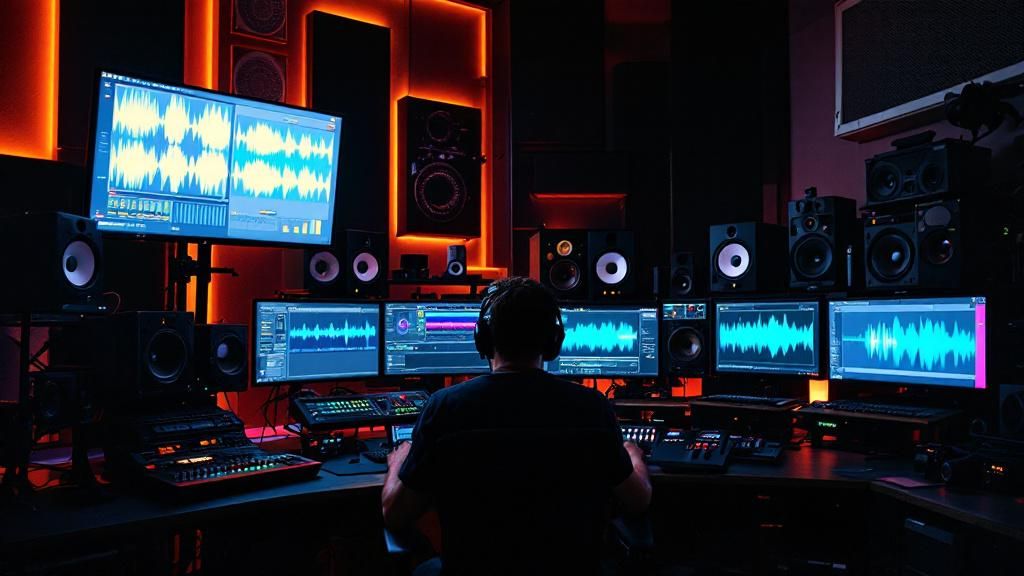How Sound Design Is Shaping the Future of Immersive Gaming
Key Takeaways
Sound design is integral to immersion, storytelling, and gameplay feedback.
Audio engines like FMOD and Unreal are transforming game audio workflows.
Games like Call of Duty and Hogwarts Legacy showcase high-end sound innovation.
Positional audio, AI sound generation, and VR soundscapes are setting new standards.
The demand for immersive, cinematic audio is reshaping how developers build games.
The Power of Sound in Today’s Gaming Experience
While stunning visuals often steal the spotlight, it’s sound that completes the gaming experience. In 2025, developers recognize that a game’s emotional tone, sense of place, and gameplay feedback all rely on thoughtful sound design.
Sound design is more than background music—it’s a storytelling device. Footsteps in the dark, rising musical tension before a boss battle, or environmental sounds that hint at nearby danger—all these subtle cues enrich player immersion. In many ways, audio is the player’s sixth sense.
Audio Engines Leading the Way in 2025
Recent industry surveys highlight how tools like FMOD Studio and Unreal Engine’s native audio system have gained traction, particularly among indie and mid-tier developers. These platforms offer:
Modular mixing for real-time control
Spatial audio capabilities for 3D immersion
Dynamic layering for responsive, evolving soundscapes
Emerging solutions like Elias and Fabric are also helping teams add cinematic audio even on smaller budgets. Sound middleware is no longer optional—it’s now central to immersive storytelling.
Why Sound Design Is a Gameplay Game-Changer
Sound has always served gameplay—from the beeps of early arcades to the surround-sound action of modern FPS titles. In today’s games, the stakes are higher:
Interactive cues: Reload clicks, incoming footsteps, or health alerts.
Atmospheric immersion: Ambient noise that changes by weather or time of day.
Emotional guidance: Swells of music that pace the player’s heart rate.
Titles like Modern Warfare III and Hogwarts Legacy exemplify these elements, using advanced sound to enhance realism and maintain engagement.

How Players and Markets Are Reacting to Audio Innovation
Players are no longer satisfied with just great visuals. Games with underwhelming audio often feel flat or unfinished. That’s why developers—and investors—are treating sound as a competitive edge.
Key trends:
Consumer Preference: Players gravitate toward games with richer sound environments.
Investor Confidence: Audio innovation is linked to increased engagement metrics.
Hardware Evolution: Devices now prioritize spatial audio support (e.g., PS5 3D Audio).
As the sound experience improves, players become more emotionally invested, increasing time-in-game and brand loyalty.
New Tech Driving Game Audio Forward
The future of game audio is unfolding fast, driven by technologies that are making audio more intelligent, spatial, and adaptive.
1. Positional Audio
Used to simulate directionality, allowing players to pinpoint threats or locate allies based on real-time sound cues.
2. AI-Generated Audio
Machine learning tools can now:
Autogenerate sound effects based on visuals
Enhance voice modulation for NPC dialogue
3. Spatial Sound in VR/AR
Enables players to hear audio differently depending on perspective, head movement, or proximity, bringing deeper immersion to virtual environments.
Integrating Sound Into Game Development Early
Many studios now embed audio design from the concept phase—not just at the final polish stage. This early integration allows:
Better synchronization between visual and audio elements
Story-driven audio arcs
More cohesive player experiences
Cross-disciplinary teams of artists, designers, and audio engineers are collaborating earlier and more often.
Case Study: High-Impact Sound Design in AAA Games
Call of Duty: Modern Warfare III (2023)
Gunfire varies by surface and environment
Footstep detail helps players read proximity
Music pacing mimics heart-pounding tension
Hogwarts Legacy
Spell sounds tailored to character progression
Environmental magic hums, weather dynamics, and reactive effects
These aren’t just add-ons—they’re pillars of what makes the games memorable.
Design Strategies for Next-Level Game Audio
For developers aiming to elevate their sound design, here are a few proven strategies:
Adopt middleware like FMOD or Wwise for flexibility.
Invest in ambient sound libraries and record custom audio.
Use adaptive music systems that shift based on player behavior.
Leverage binaural and surround mixing to mimic real-world audio perception.
Whether you’re an indie creator or AAA studio, integrating these techniques can amplify player engagement.

Looking Ahead: The Sonic Future of Gaming
With spatial computing and Web3 merging into the future of interactive content, sound will continue to play a pivotal role. From adaptive AI sound engines to community-created music NFTs for games, the soundscape is expanding.
Edge of NFT continues to explore the intersections between audio, immersive tech, and creator economies. Through our podcast and platform, we shine a spotlight on innovators redefining what players hear—and feel—in the games they love.
Frequently Asked Questions
What is sound design in video games?
It’s the creation and integration of all audio elements—music, effects, ambience, and dialogue—to enhance gameplay and storytelling.
How does sound design impact player immersion?
It builds atmosphere, delivers cues, and amplifies emotional moments, making the game world feel more real and responsive.
What tools are used for sound design in games?
Common tools include FMOD, Wwise, Unreal Engine audio systems, and AI-based sound generators.
Why is spatial audio important in gaming?
It helps players navigate environments and perceive direction and distance, enhancing realism and reaction time.
Are indie games using high-end audio tech too?
Yes. With tools becoming more accessible, even small teams are now delivering AAA-like soundscapes.
Sound’s Rising Role in Gaming’s Evolution
Sound design is no longer a background element—it’s a core pillar of gaming innovation. As players crave more immersive and emotionally resonant experiences, developers who prioritize audio will shape the future of gameplay. At Edge of NFT, we believe the games of tomorrow will be felt not just through visuals—but through every note, cue, and echo.


.jpg)

.jpg)
.webp)
.webp)
.webp)


.svg)









